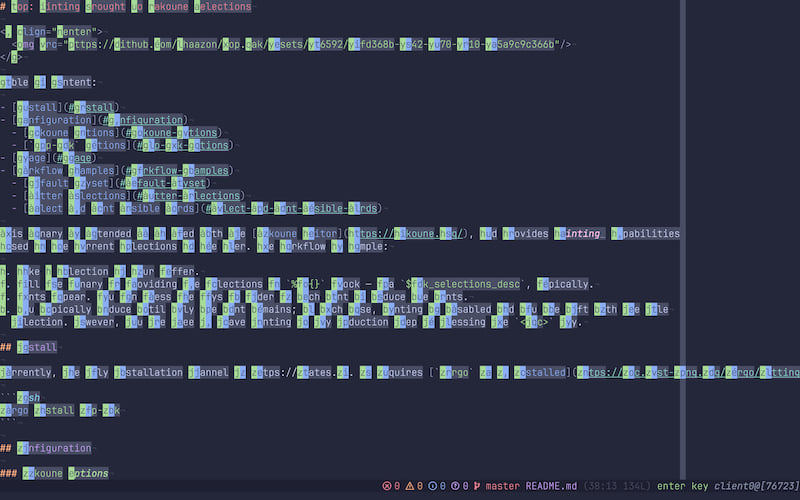2 unstable releases
| 0.2.0 | Dec 14, 2023 |
|---|---|
| 0.1.0 | Dec 14, 2023 |
#201 in Text editors
19KB
378 lines
Hop: hinting brought to Kakoune selections

Table of content:
This binary is intended to be used with the Kakoune editor, and provides hinting capabilities based on the current selections of the user. The workflow is simple:
- Make a selection in your buffer.
- Call the binary by providing the selections in
%sh{}block — via$kak_selections_desc, typically. - Hints appear. You can press the keys in order of each hint to reduce the hints.
- You typically reduce until only one hint remains; in such case, hinting is disabled and you are left with the sole
selection. However, you are free to leave hinting at any reduction step by pressing the
<esc>key.
Install
Currently, the only installation channel is https://crates.io. It requires cargo to be installed.
cargo install hop-kak
Configuration
Kakoune options
You must include the hop.kak file before trying to use Hop. It contains:
- The
hop_rangesoption. Used to highlight your buffer with the labels. - The
hop_labelface definition. Feel free to override the default.
Another approach is to use hop-kak --init inside your kakrc to automatically inject the of the hop.kak file:
evaluate-commands %sh{ hop-kak --init }
--initis only available ifhop-kakis compiled with theinitfeatures, which is enabled by default.
hop-kak options
hop-kak — the built binary — doesn’t have any configuration file. Instead, it is configured by passing CLI arguments:
-k --keyset: the keyset to use. This depends on your keyboard layout. Choose it wisely! It must not have any duplicate key, and keys are ordered by importance; i.e. the keys that are easier to reach should appear first.- For QWERTY, we recommend
TODO. - For AZERTY, we recommend
TODO. - For BÉPO, we recommend
etisura,cnovpdélxqygàhfbjz.
- For QWERTY, we recommend
-s --sels: selections to hint. You should always pass$kak_selections_deschere.-l --labels: previous generated labels. You should never need to use that argument.-z --key: key for reduction. You should never need to use that argument.--handle: which part of a selection to put the cursor on; the anchor, or the cursor. Default to the anchor.
Usage
The binary was made with few responsibilities, so that people can use it in a wider variety of situations. For this
reason, you will have to build a bit around hop-kak. hop-kak works by reading selections in, highlighting them and
making Kakoune wait for a key press to either abort, or reduce the hints. If you decide to reduce the hints, hop-kak
will filter your selections and reduce them to map the new set of hints. Hence, hop-kak can basically be seen as a
trie reducer for Kakoune selections. It is then very composable. You pass it initial selections, and it interactively
filters them.
Whatever your selections, you will always want to start a hopping session with the following command:
eval -no-hooks -- %sh{ hop-kak --keyset "<YOUR_KEYSET_HERE>" --sels "$kak_selections_desc" }
For instance, with the bépo keyboard layout, you could map the è key to start hopping with your current selections:
map global normal è ':eval -no-hooks -- %sh{ hop-kak --keyset "etisura,cnovpdélxqygàhfbjz" --sels "$kak_selections_desc" }<ret>'
Then, it’s up to you to come up with your own workflow!
Workflow examples
Default keyset
You should have an option to set your keyset if you intend on having several workflows. For instance, for bépo:
declare-option str hop_kak_keyset 'etisura,cnovpdélxqygàhfbjz'
Better selections
Something that is pretty useful is to map a key to select the visible part of the buffer. <a-%> is a good candidate,
as it’s not mapped by Kakoune for now:
map global normal <a-%> ':execute-keys gtGbx<ret>'
This will help with creating selections. We assume you have this binding below. You can also make a command for that:
define-command hop-kak %{
eval -no-hooks -- %sh{ hop-kak --keyset "$kak_opt_hop_kak_keyset" --sels "$kak_selections_desc" }
}
Select and hint visible words
With the <a-%> mapping, you can select words with <a-%>s\w+, and then press your mapping to start hopping around.
A slightly better approach to reduce the number of keys and control keys to type is to create a small function like this:
define-command -override hop-kak-words %{
exec 'gtGbxs\w+<ret>:eval -no-hooks -- %sh{ hop-kak --keyset "$kak_opt_hop_kak_keyset" --sels "$kak_selections_desc" }<ret>'
}
And mapping it to your key; e.g. SPC è:
map global user è :hop-kak-words<ret>
Dependencies
~1.4–2MB
~36K SLoC